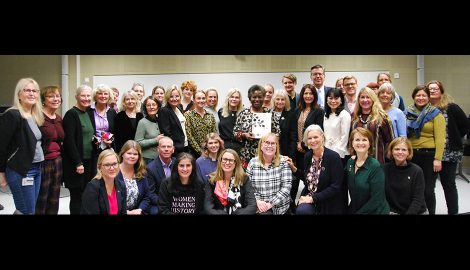Svenska Barnmorskeförbundets kickoff av Barnmorskans år 2020 #YearoftheMidwife #Midwives2020
The Swedish midwife — the development of the Swedish midwifery system
Sweden has a long tradition of educated midwives; in 2011 we celebrated 125 years of work with our Swedish Association of Midwives and 300 years of educated professional midwives in Sweden. The cadre of skilled midwives — all of whom are educated to high standards, regulated, and work closely with obstetricians/gynecologists — contributed to the decline in maternal mortality and the strengthening of sexual and reproductive health and rights (SRHR) in Sweden. Increased midwifery competence and access to midwives before, during, and after pregnancy and childbirth have been centerpieces in Sweden’s efforts and success to reduce morbidity and mortality.
Swedish midwifery practice and The Swedish Association of Midwives
Swedish midwives work independently and autonomously to provide care during normal pregnancy, childbirth, and aftercare; they also prescribe contraceptives, insert intrauterine devices and implants, and perform medical abortions. In all, they provide over 80% of Sweden’s SRH care services. The Swedish Association of Midwives have been and is the foundation for the strong and successful development/progress within midwifery in Sweden and this cover education & research, regulation and association. The education consist of a bachelor of nursing and 18 month of midwifery education program at advanced level. The Swedish Association of Midwives are responsible for the “general recommendations for midwifery practice in Sweden” and this document is reflected in the universities curriculas. Out of 6700 midwives about 170 has a PhD.
The board of our association is supported by four councils (scientific, education, ethics and international) to assure that the associations work is evidence based and strategically sound in relation to both national and international agenda and goals.
The Swedish model of care is based on close teamwork with obstetrician/gynecologist, however, the midwife is fully responsible for the normal pregnancy and delivery.
Current situation — Take leadership
Even though Sweden is one of the countries with the lowest adverse outcomes for mother and babies globally we also have our challenges. Especially midwives working in maternity and delivery care in Sweden work under pressure and this impact the quality of care. To gain power and leadership the Swedish Association of Midwives took one important step – the union – to take lead and take charge over midwives working conditions as to promote the quality of care in Sweden.
Exporting the Swedish Midwifery care model
In Sweden and elsewhere, midwifery care is today widely acknowledged as making vital and cost-effective contributions to quality maternal and newborn care (QMNC). What distingues the Sweden model of care is that we work from a life-cycle perspective covering not only care during pregnancy, delivery and post-partum but also induced abortion and contraceptive counselling including prescribing contraceptives. Investments in midwifery education and midwifery care research comprise the single most impactful means of strengthening midwifery care. A neglected unfinished agenda globally is the unmet need for abortion and woman-centered contraceptive care. Sexual and reproductive health and rights (SRHR) are an essential part of universal health coverage (UHC). Countries moving towards UHC need to consider how the SRHR needs of their population are met throughout the life course, from infancy and childhood through adolescence and into adulthood and old age. Since Sweden has a long tradition of midwives – educated to high standards, regulated, fully integrated in the health care system and strong research capacity we could be an important contributor to the capacity development needed to strengthen of sexual and reproductive health and rights (SRHR) globally.
___________________________________________________________
Svenska Barnmorskeförbundet
The Swedish Association of Midwives
___________________________________________________________




